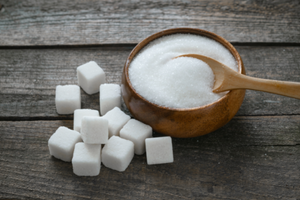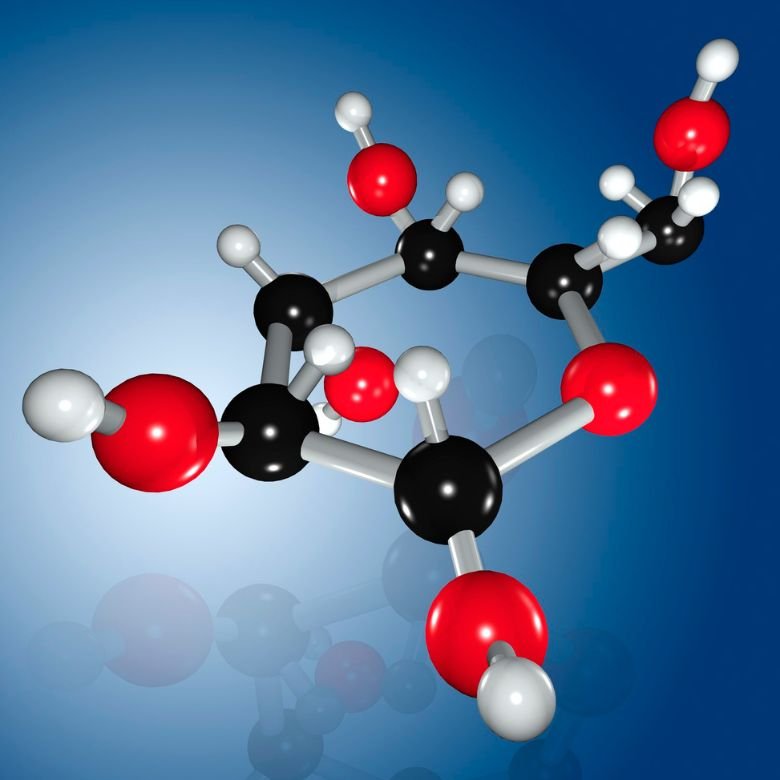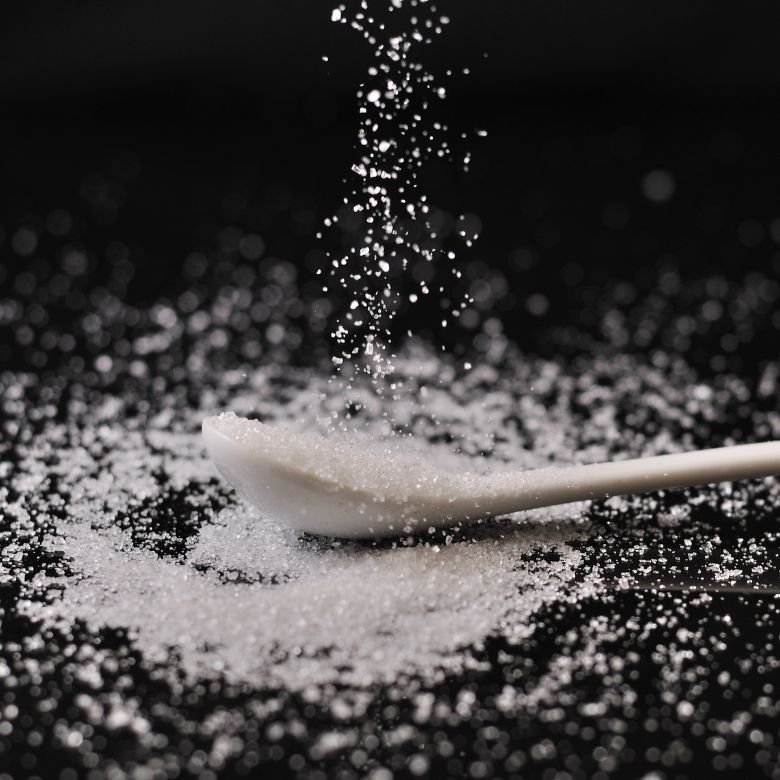In terms of molecular structure, sugars can be classified as polyhydroxyaldehydes or polyhydroxyketones and products of their condensation. That group of compounds, also referred to as carbohydrates, has the following generalised molecular formula:
Cn(H2O)n or CnH2nOn

Classification of carbohydrates
The basic division of sugars includes two subgroups: simple sugars, also called monosaccharides or monoses, and complex sugars (polyoses). Examples from the former group include trioses, tetroses, pentoses and hexoses. The latter group gathers oligosaccharides, including disaccharides, trisaccharides and tetrasaccharides, as well as polysaccharides. Complex sugars are formed by the condensation of minimum two molecules of simple sugars, into which they again decompose during hydrolysis. Unlike complex sugars, simple sugars do not hydrolyse.
The structure of monosaccharides
The generalised formula of sugars is the same for simple and complex carbohydrates, and the number of carbon atoms in monosaccharide molecules ranges from 3 to 10. Based on that number, monosaccharides are classified as, respectively, trioses, tetroses, pentoses, etc. Each of these groups contains aldoses (which are polyhydroxyaldehydes) and ketoses, being their analogical equivalents. They are named by adding the prefix aldo- or keto- to the appropriate name which suggests the number of carbons contained in the molecule, for instance aldotrioses/ketotrioses, aldopentoses/ketopentoses and aldohexoses/ketohexoses. The structure of monosaccharides generally contains a non-branched carbon chain. The functional groups they contain have their customary locations: the aldehyde group is never located in the middle of the molecule but at its edge. In the case of polyhydroxyketones, the carbonyl group –C=O is always located on the C-2 carbon. The number of hydroxyl groups can be determined using a generalised formula; their number equals the number of all oxygen atoms present in the molecule minus one. Each oxygen molecule can be connected with maximum one hydroxyl group.
Principal chemical properties of monosaccharides
The properties of monosaccharides can be explained in two ways: some of them may be described with Fischer projection formulas, and others by experiment. It is important to note that monose solutions show the effect of desmotropic equilibrium, which leads to an intramolecular chain cyclization. It can be expressed as follows:
![]()

Characteristic reactions of monosaccharides
These are reactions that allow us to detect simple sugars in a given preparation due to the appearing characteristic colour or another change that we can discern.
-
Reaction with phenyl hydrazine
It is a condensation reaction which leads to the substitution of an oxygen atom from the carbonyl group with the phenylhydrazine radical. The equimolar process of that reaction causes the formation of monosaccharide phenylhydrazones. The CHOH group connected to the second carbon atom is oxidised along with the excess reagent used. The product of that reaction is a ketone group, which then forms osazone by reacting with the excess phenylhydrazine. Given the easy crystallisation of the product, the reaction allows us to identify the monosaccharide. This is since they differ by shape and melting point.
-
Reactions with acids
When monosaccharides with nC>4 are heated with strong inorganic acids, they are their dehydration and cyclisation occurs. This leads to the formation of furan derivatives, for example hexoses produce hydroxymethyl furan. Such products, when reacting with phenols, enable the qualitative and quantitative identification of monosaccharides, with which they create coloured combinations. A special category of reactions is the Molisch’s test which involves the reaction of a monosaccharide with an alcoholic solution of α-naphthol in the presence of concentrated sulphuric acid. If the tested preparation contains a sugar, then, at the layers’ interface we can see a ring with a colour ranging from red to violet.
-
Reduction of monosaccharides
If the molecule contains a free aldehyde group, they can oxidise to acids with the use of the reducing properties of a basic environment.
-
Benedict’s test
The reaction covers monosaccharides that contain a free aldehyde group. In the presence of sodium hydroxide, it reduces copper (II) hydroxide to copper (I) oxide, which in turn changes the solution’s colour from blue into green. That characteristic colour is a result of overlaying of two colours: the orange Cu2O suspension and the blue Cu(OH)2. It is an extremely sensitive test that gives a result already when the saccharum solution equals 0.1%. At high concentrations, we can see a clear red deposit.
-
Barfoed’s test
The reaction enables to determine the speed of copper ions and to differentiate simple sugars from reducing disaccharides. As a result of the reaction with copper acetate, the sugar oxidises to carboxylic acid and produces acetic acid and copper (I) oxide in the form of a red deposit. Disaccharides oxidise much slower than monosaccharides.
-
Selivanoff’s test
It is a method of detecting ketohexoses in the preparation. For the reaction to occur it is necessary to heat the sample with a concentrated hydrochloric acid and resorcin. Its specific feature is the formation of 5-hydroxymethylfurfural and the characteristic cherry colour or the presence of a brown-and-red deposit. Their emergence after 2 minutes of heating indicates the presence of ketohexose.
-
Tollens’ test
It is a characteristic reaction of pentoses and hexoses, which consists in subjecting the preparation to hydrochloric acid. It causes the presence of a cherry colour in the case of pentoses or a yellow/brown colour in the case of hexoses.
-
Bial’s test
Bial’s test allows for identifying a pentose in the sample, which, during the reaction, loses water and produces furfural in the presence of hydrochloric acid and iron (III) ions. The furfural produces a characteristic green complex.

Chemical structure of complex sugars
The carbon chains of sugars can link with one another since they contain many hydroxyl groups. With the use of O-glycoside bonds, monosaccharide molecules produce acetal- or ketal-type bonds between themselves.
Disaccharides
Sugars from this group are produced by linking the hydroxyl groups of two monosaccharides with a glycoside bond. Popular examples of disaccharides include sucrose, maltose, lactose and trechalose.
Polysaccharides
These sugars also contain glycoside bonds, but unlike disaccharides, they are monosaccharide polymers. Depending on their structure, they can be homoglycans, if there are repeats of the structure of only one type of monosaccharide, or heteroglycans, if they consist of various types of simple sugars. The molecules normally exist as linear or branched chains. The most important compounds of this type are glucose polymers, i.e., glucans: starch, cellulose and glycogen.
Starch
This plant polysaccharide is a very common storage of glucose, being a backup source of energy. In chemical terms, it is a mixture of amylose and amylopectin in various ratios depending on the origin. Both are built of the same monosaccharide (α-D-glucopyranose) but differ by the number of glucose radicals. Amylose is a soluble starch that has simple and non-branched chains which wind to form a helix, as well as 200 to 300 glucose radicals with a curve at every 6 to 8 of them. Amylopectin is an insoluble, branched starch that may contain even hundreds of thousands of glucose radicals. It also forms a helix, but the curve may fall every 24 to 30 glucose radicals.
Characteristic properties of polysaccharides
-
Hydrolysis
Unlike most monosaccharides, polysaccharides undergo the reaction of hydrolysis. It exists in heating conditions with diluted acids or in the presence of enzymes. Depending on the reaction conditions, the products may be polysaccharides with smaller molecules, oligosaccharides and monosaccharides which composed the polysaccharide that underwent the reaction.
-
Qualitative analysis of starch with the use of iodine
The amylose present in starch, once dissolved, winds in space to form a left-hand helix that is stabilised by hydrogen bonds produced between the free hydroxyl groups of monosaccharides. Once iodine is added, amylose forms a blue complex which is not the result of a reaction but rather the effect of trapping the reagent molecules inside the helix. The colour, characteristic of iodine, results from the motion of electrons along the chain of iodine molecules and from the absorption of light by the produced complex. If it is heated, the hydrogen bonds are broken off, the iodine is released, and the colour fades out. In a reaction between amylopectin and iodine, we can see a violet-and-red colour. If we add iodine to starch, the colour will be violet-and-blue.